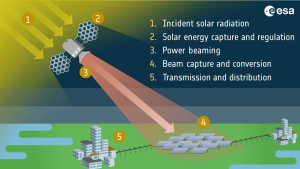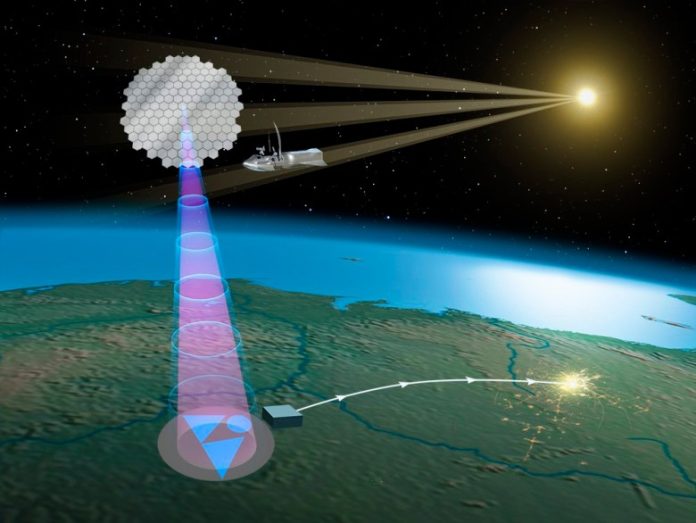Electrical engineer Ed Tate was skeptical of proposals for space-based solar power when he initially heard about the concept seven years ago.
“My first reaction was, ‘That really sounds like science fiction. I don’t think that will work,’” Tate said in March at the Satellite 2025 conference.
Now, Tate said, he’s “personally invested in making it happen” as chief technology officer for Virtus Solis Technologies, a Michigan startup planning to assemble a solar array in orbit in 2027.
Incremental progress
Tate is not alone in reconsidering the promise of space-based solar power (SBSP). Long deemed unaffordable because of the massive orbital infrastructure required, SBSP is gaining credibility as the SpaceX Starship and Blue Origin New Glenn seem poised to slash launch costs and offer room for modular SBSP antennas. Those antennas could be connected robotically in geostationary orbit to form kilometer-scale arrays.
In recent years, solar champions have focused on incremental progress, breaking down technical hurdles to make the concept more feasible instead of racing to establish space solar farms.
The Air Force Research Laboratory and Northrop Grumman, for example, proved the ability to beam radio-frequency energy toward various antennas in 2022 ground testing.

European Space Agency space-based solar power published in 2022. Credit: ESA
Beginning this spring, Andrew Jones will be explaining the business, politics and technology in Chinese space activities as part of a new biweekly newsletter.
By submitting this form, you agree to the SpaceNews Privacy Policy and Terms and Conditions and to receive email from us. You can opt-out at any time.
Florida startup Star Catcher demonstrated a similar feat March 21, sending concentrated sunlight more than 100 meters to power off-the-shelf solar arrays. China’s dominant satellite builder, China Academy of Space Technology, is preparing to demonstrate high-voltage transfer and wireless-power transmission from a spacecraft in low Earth orbit in 2028. And the United Kingdom plans to launch a space-based solar power prototype by 2030.
“Space solar has been a difficult challenge to solve, not just because of the engineering side, but also the finance side,” Tate said. “Interest in some of these incremental solutions is turning it into an investment class.”
Early revenue
Companies also are bringing in money from SBSP component and subsystem development.
With 1.2 million pounds ($1.6 million) in U.K. government funding, Space Solar Ltd. is working with the University of Cambridge to develop lightweight thin-film gallium arsenide photovoltaics for Constant Aperture, Solid-State, Integrated, Orbital Phased Array (Cassiopeia), a lightweight microwave antenna for SBSP.
Reducing the weight of antennas and making sure they can be packed tightly in a rocket fairing are critically important tasks because launch costs, while falling, remain a major capital expenditure.
“It’s not just about mass, it’s about volume as well,” said Martin Soltau, the co-CEO of Space Solar.

Satellite panelists from left to right: Moderator Karen Jones, Aerospace Corp. senior space policy analyst and economist, Ed Tate, Virtus Solis Technologies, chief technology officer, Paul Jaffe, DARPA Tactical Technologies Office program manager, Martin Soltau, Space Solar co-CEO. Credit: Satellite 2025 Conference
Meanwhile, Virtus Solis and Silicon Valley startup Orbital Composites are preparing to begin robotic assembly of hexagonal photovoltaic tiles — essentially solar panels — in a medium Earth Molniya orbit in 2027. Their goal is transmission of more than one kilowatt to Earth.
Virtus Solis won a $1.92 million contract in January from the Advanced Research Projects Agency-Energy to develop technology for wirelessly transferring radio-frequency power. Highly efficient, miniature RF components will benefit SBSP campaigns as well as unrelated space programs, Tate said.
Hurdles to clear
In spite of progress on components, the challenge remains of establishing solar arrays in geostationary orbit to beam energy to Earth. SBSP faces public skepticism as well as technical, financial and regulatory hurdles.
“It is going to be important to build credibility for power beaming more generally,” said Paul Jaffe, project manager in the Defense Advanced Research Projects Agency’s Tactical Technology Office. “A lot of times, I get asked, ‘Is this going to fry birds?’ People are surprised that you can send energy wirelessly using electromagnetic waves.”
Civil and military utility
But despite the sizable challenges, the opportunities are enormous as well, said Jaffe, former Naval Research Laboratory Innovation Power Beaming and Space Solar Portfolio lead.
“The sun is the closest thing we have in our solar system to an unlimited source of energy,” Jaffe said. “The more we can take advantage of that, the better.”
Unlike terrestrial solar power, orbiting solar stations could deliver energy around the clock. And satellites could send that power wherever it was needed.
The military utility of beaming power to terrestrial, airborne or maritime units is obvious, experts said.
Flying tankers to deliver fuel to remote locations is “not a practical way to get energy to where we need it for defense purposes,” Jaffe said. “If we can beam energy to the places we need it without putting people and equipment at risk, that’s a big deal.”
Jaffe noted that DARPA is not currently investing in solar-power satellites but is funding development of technology to transmit power wirelessly over long distances.
So when will this begin producing power?
Space Solar is under contract to deliver 30 megawatts to Reykjavik Energy of Iceland by 2030.
“That’s when everyone is going to see you’ve overcome the regulatory issues, you’ve demonstrated the technology, you’ve demonstrated the operations,” Soltau said. “This is going to provide affordable, abundant energy at a very low cost.”
This article first appeared in the April 2025 issue of SpaceNews Magazine with the title “Harnessing the Sun.”






